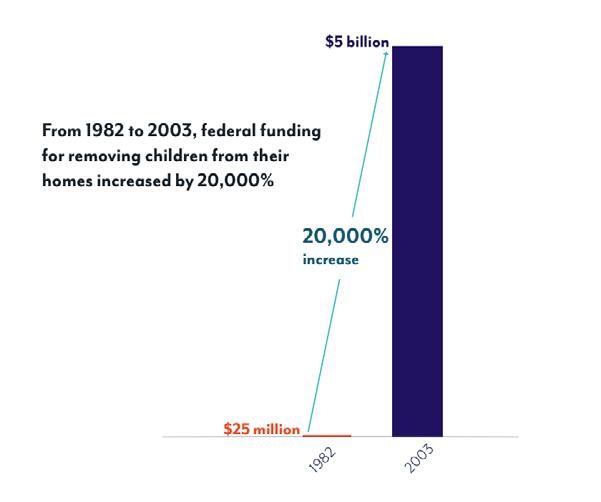
3 minute read
FROM WELFARE TO WAR: THE CRIMINALIZATION, VILLAINIZATION, AND SEPARATION OF BLACK FAMILIES
As described in the last two subsections, the historical origins of FRS have always been about maintaining white racial dominance, and more recently have been strategies to divest public funds from Black mamas. Policy makers must understand that hospital drug testing policies and subsequent reporting to FRS are born of these same histories, while also being a part of the antiBlack tactics designed by the War on Drugs.
When the War on Drugs began, the population of parents and children under the surveillance and control of the FRS increased sharply, with the starkest increases occurring among Black and Indigenous parents and children. There was a convergence of neoliberal and anti-black and anti-indigenous policies that encouraged this surge—such as the enactment of the Child Abuse Prevention and Treatment Act (CAPTA) which required states to enact mandatory reporting systems and policies and the increased practice of drug testing Black and Brown mothers at birth, primarily based on a grossly exaggerated “crack baby” mythology.25
Advertisement
At the same time, the federal government poured unprecedented funds into reimbursing states for the costs of removing children from their mamas (with no comparable funding increase for reunification funds) and stagnated or decreased funds for necessities for families such as drug treatment and associated healthcare, housing, child care, etc. In fact, CAPTA replaced a policy that would have created a childcare entitlement, which had bipartisan support but was vetoed by Nixon as part of this divestment campaign.26
While the hysteria surrounding crack cocaine use was eventually found to be unsupported by science,27 the policies and procedures the medical community and FRS created during this era continue to inform how reproductive healthcare for people who use drugs is administered and regulated. One such example is the rapid expansion of the CAPTA and the Comprehensive Addiction and
Recovery Act (CARA) from 2002-2018 28 The targeting of parenting people who use drugs also extended to the administration of social service benefits when Congress passed the Personal Responsibility and Work Opportunity Reconciliation Act (PRWORA) in 1996. This legislation greatly affected the ability of people who used drugs to care for their families. Drug testing implemented by PRWORA disproportionately targeted low-income families and kept them from receiving benefits, making them more susceptible to child removal. At the same time, the US made it harder for families to access benefits; we saw federal funding for removing children from their homes increase by approximately 20,000% (from 1982 to 2003) and simultaneously the increase of federal drug control funding increased by nearly 400%. Surveillance became the norm, and as prison rates grew, so did child removals.29
From 1986 to 1996, the rate of children moved from their homes to the foster system increased by over 100%.30 This simultaneous escalation of the family regulation and criminal legal systems calls back to the origins of FRS, where the primary goal was exploitation or elimination, and Black enslaved people and Indigenous people faced near-constant threats of family separation.









